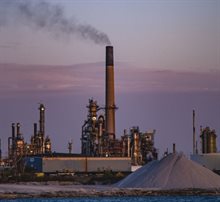Although even the experts at TNO Vector and TNO Energy and Materials Transition do not have ready-made answers, they do know which strategic choices are needed now to prepare the Netherlands for a future in which CCU could even contribute to negative CO2 emissions in the long term.
The chemical and fuel sectors play a key role in achieving a future-proof and circular economy in the Netherlands. But this is no small feat.
To begin with, the use of fossil fuels must be reduced as much as possible, partly through electrification. At the same time, the use of carbon remains essential - not only for the production of chemicals, but also for fuels, such as those used in aviation. This must be done using carbon from circular sources: from biomass, for example, or from waste. But capturing and using CO2 is also an important option, one that is increasingly being mandated by the EU.

‘Based on available information from previous studies and market initiatives, we took a broad view and then mapped out the most promising CCU routes for the Netherlands.’
Nicole van Klaveren, Innovation orchestrator at TNO Vector
Waiting is not an option
Meanwhile, CCU brings significant challenges. In addition to financing issues, it is crucial to develop innovations that raise CCU technologies to a higher TRL level. And while the business case is currently not very attractive, waiting is not an option - otherwise, the Netherlands risks missing the boat. In short: an interesting challenge that urgently requires a strategy for all stakeholders to get started.
Vision for the future
It helps that the topic is now high on the political agenda in The Hague.
Carbon is a fundamental building block for the chemical industry, used to make products such as plastics, coatings, detergents and medical products. Currently, this carbon mainly comes from fossil resources, such as oil and natural gas. To safeguard future earning potential and reduce strategic dependence, the use of fossil resources must be phased out as much as possible. By using carbon from sustainable sources, a climate-neutral and circular economy can be achieved, and the strategic autonomy of the Netherlands can be increased.
The above passage is taken directly from the ‘Vision on sustainable carbon in the chemical industry’, recently published by the caretaker cabinet. This aligns perfectly with the views of Nicole van Klaveren and Karin van Kranenburg of TNO Vector. They have clear ideas about how the Netherlands can become a key player in CCU in the long term, and how this will contribute to the sustainability of the chemical and fuel sectors.
Want to know more about the quick scan?
The Dutch industry aims for climate neutrality by 2050 and a circular economy, with a 67% CO₂ reduction by 2030. Achieving this requires alternative carbon sources and the recovery of carbon from waste through bio-based feedstocks, recyclates, and CO₂ (CCU). For more information, read the quick scan.
Opportunities and barriers
‘What are the main opportunities and barriers for CCU development in the Netherlands? That was the first thing we looked at when preparing a quick scan,’ says Van Klaveren.
‘Based on available information from previous studies and market initiatives, we took a broad view and then mapped out the most promising CCU routes for the Netherlands. The major advantage of CCU is that there is always plenty of CO2 available - concentrated in point sources and in the atmosphere - but the downside is that a huge amount of energy is needed to use that molecule for the production of chemicals and fuels. And as long as that is not green energy, CCU only contributes to sustainability to a limited extent. This calls for a strategy focused on the long term, but which also requires investments now to improve CCU technologies and establish the necessary value chains.’

‘We certainly do not need to produce everything domestically, which is practically impossible, but for some chemicals and fuels, it is essential to keep production in our own hands.’
Karin van Kranenburg, Senior consultant sustainable hydrogen, fuels and chemistry at TNO Vector
Geopolitical interests
Sustainability in the chemical and fuel sectors is not only important for the climate, but also strategically vital for the autonomy of the Netherlands. Van Klaveren: ‘It helps that our country has a strong knowledge and innovation base. There are further advantages, such as a concentration of integrated industrial clusters and seaports, and well-organised access to the European market. All this gives us a good starting position for developing and applying CCU in the Netherlands.’
‘We certainly do not need to produce everything domestically, which is practically impossible, but for some chemicals and fuels, it is essential to keep production in our own hands,’ Van Kranenburg emphasises. She cites certain gases that must be processed at the production site or products of great economic and strategic importance as examples.
‘You cannot avoid considering the international context and geopolitical interests in this matter,’ Van Klaveren agrees.
Zooming out
And that international context is also a key focus of the TNO programme VoltaChem. ‘It starts with the fact that the fuel and chemical industries in the Netherlands are not isolated, but part of the ARRRA cluster, which stands for Antwerp-Rotterdam-Rhine-Ruhr Area,’ says Van Kranenburg.
‘The Netherlands already has a strong knowledge position in CCU, as do Germany and Belgium. This creates opportunities that can contribute to a sustainable chemical and fuel sector in Europe. Zooming out even further, you see that the sustainability of chemicals and fuels requires a different approach than the sustainability of electricity production. The markets for fuels and chemicals are global markets. For a level playing field, it is important to make agreements on sustainability not only at the European level, but also globally.’

‘Without swift action, the cluster will lose ground. With Power-to-X, biobased routes and recycling, we can create new business models and value right now.’
Monalisa Goswami, Senior Business Developer Power2Chemicals at TNO
Embracing CCU technology now
A major challenge remains the need for large amounts of sustainable energy to use CCU for the sustainability of the fuel and chemical sectors in the Netherlands. In the short term, this sustainable energy is not available on a large scale or at competitive costs. Therefore, it is essential to embrace CCU technology now and invest in the necessary innovations, equipment, chain cooperation and policy support. The business case may not be attractive at present, but in ten, twenty or thirty years, CCU will become indispensable for the sustainability of our country.
In fact, if CCU is combined with CO2 from biomass, it could even lead to negative CO2 emissions. Monalisa Goswami, Senior Business Developer Power2Chemicals at TNO adds: 'Without swift action, the cluster will lose ground. With Power-to-X, biobased routes and recycling, we can create new business models and value right now.'
Two-strategy approach
And what is the best approach? On this point, both Van Kranenburg and Van Klaveren fully support the two-strategy approach advocated by VoltaChem:
- Develop strategic production capacity in the Netherlands, using CCU to produce key chemicals and sustainable fuels that reduce dependence on suppliers outside Europe.
- Become a global technology provider in CCU. In this way, the Netherlands can leverage its existing knowledge position and apply it in regions where CCU will be implemented on a large scale.
It is important to further develop the technology position in initial factories in the Netherlands and the ARRRA cluster. In this way, both strategies can reinforce each other.
Harnessing Power-to-X for a sustainable carbon future
Power-to-X CCU technologies replace fossil carbon with circular carbon. This is crucial for a sustainable chemicals and fuels sector, especially where electrification or hydrogen is not feasible. Carbon-based fuels will remain necessary for heavy-duty transport. Discover how this works.






